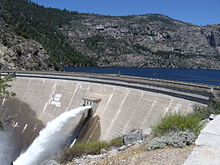O'Shaughnessy Dam (California)
| O'Shaughnessy Dam | |
|---|---|
 |
|
| Location | Tuolumne County, California, United States |
| Coordinates | 37°56′51″N 119°47′18″W / 37.94750°N 119.78833°WCoordinates: 37°56′51″N 119°47′18″W / 37.94750°N 119.78833°W |
| Purpose | Water supply Hydroelectricity |
| Status | Operational |
| Construction began | August 1, 1919 |
| Opening date | May 24, 1923 |
| Owner(s) | San Francisco PUC |
| Dam and spillways | |
| Type of dam | Concrete arch gravity |
| Impounds | Tuolumne River |
| Height | 430 ft (130 m) |
| Length | 900 ft (270 m) |
| Elevation at crest | 3,812 ft (1,162 m) |
| Width (base) | 308 ft (94 m) |
| Reservoir | |
| Creates | Hetch Hetchy Reservoir |
| Total capacity | 360,400 acre⋅ft (444,500,000 m3) |
| Catchment area | 459 sq mi (1,190 km2) |
| Surface area | 1,972 acres (798 ha) |
| Power Station | |
| Turbines | 3 x Pelton turbines at Kirkwood Powerhouse 2 x Pelton turbines at Moccasin Powerhouse |
| Installed capacity | 234 MW |
| Annual generation | 976 GWh |
O'Shaughnessy Dam is a 430-foot (131 m) high concrete arch-gravity dam in Tuolumne County, California, in the United States. It impounds the Tuolumne River, forming the Hetch Hetchy Reservoir at the lower end of Hetch Hetchy Valley in Yosemite National Park, about 160 miles (260 km) east of San Francisco. The dam and reservoir are the source for the Hetch Hetchy Aqueduct, which provides water for over two million people in San Francisco and other municipalities of the west Bay Area. The dam is named for engineer Michael O'Shaughnessy, who oversaw its construction.
Although San Francisco had sought Tuolumne River water as early as the 1890s, this project did not move forward until the disastrous earthquake and fire of 1906, which underscored the insufficiency of the existing water supply. The Hetch Hetchy Valley – then compared to Yosemite Valley for its scenic beauty – was chosen for its water quality and hydroelectric potential, but the location within the national park generated controversy. An act of Congress was required to circumvent federal protection of the Tuolumne River, with the reasoning that public land should be developed for the public benefit.
Construction of the dam started in 1919 and was finished in 1923, with the first water delivered in 1934 after numerous delays. From 1935–38 the dam was raised to increase its capacity for water supply and power generation. The dam, aqueduct and appurtenant hydroelectric systems are collectively known as the Hetch Hetchy Project. Deriving from a largely wild and pristine area of the Sierra Nevada, the Hetch Hetchy supply is some of the cleanest municipal water in the US, requiring only primary filtration and disinfection.
...
Wikipedia

